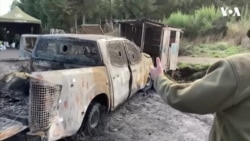ເມື່ອສິບປີກ່ອນ ຜູ້ນຳທາງຕາມສາຍພູຊາວ ເນປານ ທ່ານດາວາ ທາຊີ ເຊີຣປາ ໄດ້ຕໍ່ສູ້ເພື່ອຊີວິດຂອງລາວ ຫຼັງຈາກທີ່ໄດ້ປະສົບກັບຫິມະເຈື່ອນຢູ່ພູ ເອເວີເຣັສ ທີ່ເປັນນຶ່ງໃນສາຍພູຫິມະໄລ ຊຶ່ງໃນເວລານັ້ນ ເປັນໄພຫາຍະນະທີ່ຮ້າຍແຮງ ທີ່ສຸດຕໍ່ພູທີ່ສູງສຸດແຫ່ງນີ້.
ອຸບັດເຫດດັ່ງກ່າວ ທີ່ໄດ້ສັງຫານຜູ້ນຳທາງຊາວ ເນປານ 16 ຄົນເມື່ອວັນທີ 18 ເມສາ 2014 ເຊິ່ງເນັ້ນຢ້ຳໃຫ້ເຫັນເຖິງຄວາມອັນຕະລາຍອັນໃຫຍ່ຫຼວງທີ່ພວກ ເຂົາເຈົ້າປະເຊີນ ເພື່ອໃຫ້ພວກລູກຄ້າຊາວຕ່າງຊາດຈ່າຍຄ່າຈ້າງສູງທີ່ສູງ ເພື່ອນຳທາງຂຶ້ນພູທີ່ເປັນຄວາມໄຝ່ຝັນຂອງພວກເຂົານັ້ນ.
ຖ້າປາດສະຈາກວຽກງານທີ່ສຳຄັນຂອງເຂົາເຈົ້າໃນການຂຸດທາງປີນຂຶ້ນ, ຕິດຕັ້ງ ເຊືອກ, ຊ້ອມແປງຂັ້ນໄດ ແລະແບກເຄື່ອງຂອງທີ່ໜັກຂຶ້ນພູດັ່ງກ່າວນັ້ນ ຈະມີ ຊາວຕ່າງປະເທດພຽງບໍ່ເທົ່າໃດຄົນ ທີ່ສາມາດປີນຂຶ້ນໄປຈອມພູທີ່ເປັນຕາຢ້ານ ຫຼາຍນັ້ນ.
ເມື່ອນຶ່ງທົດສະວັດຜ່ານມາ ແຜ່ນຫິມະສ່ວນນຶ່ງໄດ້ເຈື່ອນລົງມາໃສ່ພວກຜູ້ນຳທາງ ຊາວ ເນປານ ຂະນະທີ່ພວກເຂົາແບກເຄື່ອງຂອງທີ່ໜັກຂຶ້ນໄປຕາມຮ່ອມນ້ຳ ກ້ອນທີ່ເອີ້ນວ່າ ຄຳບູ (Khumbu) ຊຶ່ງກັນດານຫຼາຍໂດຍມີສະພາບອາກາດ ທີ່ໜາວເຢັນສຸດ ແລະມືດມິດ.
ແຮງຂອງຫິມະເຈື່ອນໄດ້ພັດເອົາທ່ານ ດາວາ ທາຊີ ໄປໄກປະມານ 10 ແມັດ ເຮັດໃຫ້ກະດູກຂ້າງ ກະດູກບ່າໄຫລ່ເບື້ອງຊ້າຍ ແລະດັງຂອງລາວບາດເຈັບ.
ທ້າວ ດາວາ ທາຊີ ໃນຕອນນັ້ນມີອາຍຸ 22 ປີ ຈື່ໄດ້ວ່າ ໝູ່ເພື່ອນຂອງລາວ ຫຼາຍຄົນໄດ້ເສຍຊີວິດ. ສົບຂອງສາມຄົນໃນນັ້ນ ບໍ່ໄດ້ຖືກເກັບກູ້ມາເລີຍ.
“ຂ້ອຍໂຊກດີທີ່ໄດ້ລອດຊີວິດ” ລາວກ່າວຕໍ່ອົງການຂ່າວເອແອັຟພີ. ແລະກ່າວ ຕໍ່ໄປວ່າ “ຢູ່ໃນໂຮງໝໍ, ເມື່ອໃດທີ່ຂ້ອຍພະຍາຍາມທີ່ຈະນອນ, ພວກເຂົາຈະ ປາກົດຕົວຕໍ່ໜ້າສາຍຕາຂອງຂ້ອຍຢູ່ເລື້ອຍໆ.”
ໄພຫາຍະນະດັ່ງກ່າວ ໄດ້ນຳໄປສູ່ການປະທ້ວງເພື່ອໃຫ້ປັບປຸງສະຫວັດດີການ ແລະສະພາບການສຳລັບພວກຜູ້ທາງທັງຫຼາຍ ແລະ ປິດການປີນຂຶ້ນຈອມພູນຶ່ງລະດູແບບບໍ່ເຄີຍມີມາກ່ອນ.
Ten years ago, Nepali mountain guide Dawa Tashi Sherpa was fighting for his life after being hit by an avalanche on Everest which was then the deadliest disaster on the world's highest mountain.
The accident, which killed 16 Nepali guides on April 18, 2014, shone a spotlight on the huge dangers they face to let high-paying foreign clients reach their dreams.
Without their critical work to carve out climbing routes, fix ropes, repair ladders and carry heavy gear up the mountain, few foreign visitors could make it to the daunting peak's top.
A decade ago, a wall of snow barrelled through the Nepali guides as they heaved heavy equipment up the treacherous high-altitude Khumbu icefall in the freezing dark.
The force of the avalanche tossed Dawa Tashi about 10 metres (33 feet) down, injuring his rib cage, left shoulder blade and nose.
Dawa Tashi, then aged 22, recalled his friends who died. Three of their bodies were never recovered.
"I was lucky to survive," he told AFP. "In the hospital, whenever I tried to sleep, they would appear in front of my eyes."
The disaster led to protests for improved benefits and conditions for the guides, and an unprecedented shutdown on the peak for a season.












ຟໍຣັມສະແດງຄວາມຄິດເຫັນ